Related Research Articles

The Cunene or Kunene is a river in Southern Africa. It flows from the Angola highlands south to the border with Namibia. It then flows west along the border until it reaches the Atlantic Ocean. It is one of the few perennial rivers in the region. It is about 1,050 kilometres (652 mi) long, with a drainage basin 106,560 square kilometres (41,143 sq mi) in area. Its mean annual discharge is 174 m3/s at its mouth. The Epupa Falls lie on the river. Olushandja Dam dams a tributary of the river, the Etaka, and helps provide the Ruacana Power Station with water.
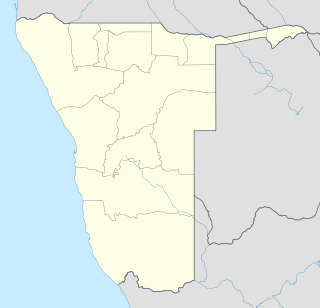
Ruacana is a town in Omusati Region, northern Namibia and the district capital of the Ruacana electoral constituency. It is located on the border with Angola on the river Kunene. The town is known for the picturesque Ruacana Falls nearby, and for the Ruacana Power Station.
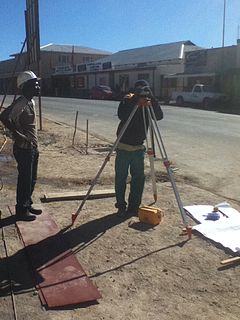
NamPower is the national power utility company of Namibia. NamPower was founded in 1964 as the South West Africa Water and Electricity Corporation (SWAWEK) by the government of South Africa. Its offices are located in Windhoek. The early history of the company revolves around the Kunene River hydroelectric project.
Calueque is a town next to a dam and pumping station of the same name on the Kunene River in the Kunene Province of southern Angola. The water project is linked to Ruacana, 20 km (12 mi) away in Namibia, where the Ruacana Power Station is. This dam is one of the last landmarks along the Kunene River, prior to the Kunene becoming a border feature between Angola and Namibia. A 300 km (190 mi) pipeline and canal extends across the border into Namibia, supplying towns as far away as Oshakati in Ovamboland with water. The dam was completed in 1976. However, due to the onset of the Angolan civil war following independence, the full master plan for the scheme was not realised by the South African and Portuguese governments.

The Xiluodu Dam is an arch dam on the Jinsha River, i.e. the upper course of the Yangtze in China. It is located near the town of Xiluodu in Yongshan County of Yunnan Province but the dam straddles into Leibo County of Sichuan Province on the opposite side of the river. The primary purpose of the dam is hydroelectric power generation and its power station has an installed capacity of 13,860 MW. Additionally, the dam provides for flood control, silt control and its regulated water releases are intended to improve navigation downstream. Construction on the dam and power station began in 2005 and the first generator was commissioned in 2013, the last in 2014. It is operated by China Yangtze Power and is currently the third-largest power station with the fourth-tallest dam in the world.

The Kiambere Hydroelectric Power Station is an earth-filled embankment dam on the Tana River near Kiambere, Kenya. It straddles the border of Embu and Kitui Counties in Eastern Province. The primary purpose of the dam is hydroelectric power generation and it supports a 165 MW power station. Construction on the dam began in 1983 and it was completed in 1987. The power station was commissioned in 1988. Beginning in 2008 both turbine-generators were upgraded from 72 MW to 82.5 MW. They were commissioned in 2009. US$95 million in funding for the original project was provided by the World Bank. The power station is operated by Kenya Electricity Generating Company and is part of the Seven Forks Scheme.
Olushandja Dam is a dam on the Etaka River outside of Oshakati in the Oshana Region of Namibia. The dam was completed in 1990. Its lake has a maximum capacity of 42.331 million cubic metres, and stores water from the Calueque Dam on the Cunene River in nearby Angola which supports the Ruacana Power Station downstream.
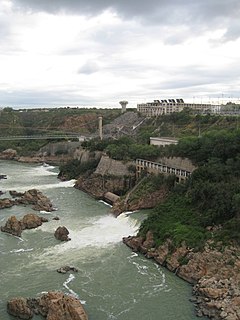
The Paulo Afonso Hydroelectric Complex, also known as the Paulo Afonso Complex, is a system of three dams and five hydroelectric power plants on the São Francisco River near the city of Paulo Afonso in Bahia, Brazil. The complex exploits an 80-metre (260 ft) natural gap on the river, known as the Paulo Afonso Falls. Constructed in succession between 1948 and 1979, the dams support the Paulo Afonso I, II, III, IV and Apollonius Sales (Moxotó) power plants which contain a total of 23 generators with an installed capacity of 4,279.6 megawatts (5,739,000 hp).

The Salto Osório Hydroelectric Power Plant is a dam and hydroelectric power plant on the Iguazu River near Osório in Paraná, Brazil. It is the second dam upstream of the Iguazu Falls and was completed in 1979. The power station has a 1,078 MW capacity and is supplied with water by a rock-fill embankment dam.

The Salto Santiago Hydroelectric Power Plant is a dam and hydroelectric power plant on the Iguazu River near Santiago in Paraná, Brazil. It is the third dam upstream of the Iguazu Falls and was completed in 1979. The power station has a 1,420 MW capacity and is supplied with water by a rock-fill embankment dam.
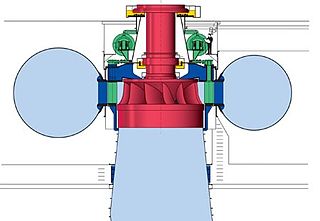
The Chutak Hydroelectric Plant is a run-of-the-river power project on the Suru River in Kargil district in the Indian union territory of Ladakh. The barrage of the project is at Sarze village and the powerhouse is located on the right bank of the Suru near Chutak Village. The project construction began on 23 September 2006, and the first three generators were commissioned in November 2012. The fourth was commissioned in January 2013.

The Yantan Dam is a gravity dam on the Hongshui River near Dahua County, Guangxi China. The main purpose of the dam is hydroelectric power production and it has an associated 1,210 MW power station consisting of 4 x 302.5 MW Francis turbine-generators.

Stave Falls Dam is a dual-dam power complex on the Stave River in Stave Falls, British Columbia, Canada. The dam was completed in 1912 for the primary purpose of hydroelectric power production. To increase the capacity of Stave Lake, the dam was raised in 1925 and the Blind Slough Dam constructed in an adjacent watercourse 500 m (1,600 ft) to the north, which was the site of the eponymous Stave Falls. In 2000, the dam's powerhouse was replaced after a four-year upgrade. The powerhouse was once British Columbia's largest hydroelectric power source and is a National Historic Site of Canada.

The Kavşak Bendi Dam is a concrete-face rock-fill dam on the Seyhan River bordering Kozan and Aladağ districts in Adana Province, Turkey. Construction on the dam began in 2008 and the first generator was commissioned in 2013. The two remaining generators were commissioned by April 2014. The primary purpose of the dam is hydroelectric power generation. Water is sent about 2.5 km (1.6 mi) downstream where it meets the power station which contains three 59 MW Francis turbine-generators.

The Kindaruma Hydroelectric Power Station, also Kindaruma Dam is an embankment dam with two gravity dam sections on the Tana River in Kenya. It straddles the border of Embu and Machakos counties in Kenya. The primary purpose of the dam is hydroelectric power generation and it supports a 72 megawatts (97,000 hp) power station. It is Kenya's first post-independence hydroelectric power plant. It was commissioned in 1968 as part of the Seven Forks Scheme. The power station is operated by Kenya Electricity Generating Company.
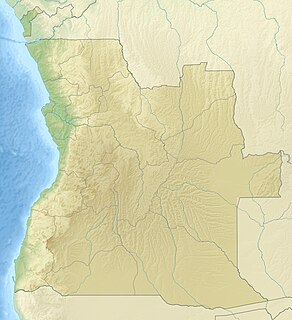
The Gove Dam is an embankment dam on the Kunene River about 75 km (47 mi) south of Huambo in Huambo Province, Angola. The purpose of the dam is to control floods and generate hydroelectric power. It has a power generating capacity of 60 megawatts (80,000 hp) each), enough to power over 30,000 homes.

The Snoqualmie Falls Hydroelectric Plant is located just north of Snoqualmie in King County, Washington state, US. It is situated about 22 mi (35 km) east of Seattle. Located just below the Snoqualmie Falls, the power plant consists of two power houses, Plant 1 and Plant 2. Plant 1 was completed in 1899 and is located underground. It is the first completely underground hydroelectric power plant ever built in the world. Plant 2 was built in 1910 and is located along the right bank of the Snoqualmie River. Both plants receive water from a small reservoir created by a weir atop the falls. Plant 1 has an installed capacity of 13.7 MW and Plant 2 a capacity of 40.2 MW for a total installed capacity of 53.9 MW, enough to power 40,000 homes.
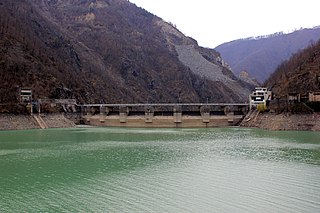
The Jablanica Dam is an arch-gravity dam on the Neretva River about 4 km (2.5 mi) northeast of Jablanica in the Herzegovina-Neretva Canton of Bosnia and Herzegovina. The dam was constructed between 1947 and 1955 with the primary purpose of hydroelectric power production. The power station was commissioned in two stages, from 1955 until 1958. The first generator was commissioned in February 1955. An upgrade in 2008 increased the installed capacity of the power station from 150 MW to 180 MW. The dam's power station is located about 4.4 km (2.7 mi) to the southeast near Jablanica and discharges back into the Neretva River. It contains six 30 MW Francis turbine-generators for an installed capacity of 180 MW. The difference in elevation between the reservoir and power station afford a hydraulic head of 111 m (364 ft). The dam is 85 m (279 ft) tall and creates Jablanica lake. The dam and power station are owned and operated by Elektroprivreda Bosne i Hercegovine.

The Saucelle Dam is a gravity dam on the Douro River. It is located about 4 km (2.5 mi) west of Saucelle in the province of Salamanca, Castile and León, Spain. The dam straddles the border of Spain and Portugal but is owned an operated by Spain's Iberdrola. Construction on the dam began in 1950 and was completed in 1956. The primary purpose of the dam is hydroelectric power production and it has an installed capacity of 520 MW. The power is produced by two power stations, both located just downstream. Saucelle I was commissioned in 1956 and contains four 62.5 MW Francis turbine-generators for an installed capacity of 251 MW. Saucelle II is located underground and was commissioned in 1985. It contains two 134.5 MW Francis turbine-generators for an installed capacity of 269 MW.

The Lauca Dam is a gravity dam currently being constructed on the Cuanza River in Angola. It is situated on the borders of Cuanza Norte, Cuanza Sul and Malanje Provinces. Construction began in 2012. The first generator of the 2,069.5 MW power station was commissioned on August 4, 2017, when the power plant was officially inaugurated by President José Eduardo dos Santos. The dam and power station will cost US$4.3 billion, funded in part by the Government of Brazil. When complete, it will be the largest power station in the country.
References
- ↑ "Ruacana Power Station". NamPower. Retrieved 22 January 2015.
- ↑ "Ruacana fourth turbine commissioned". The Namibian. 6 April 2012. Retrieved 22 January 2015.
- ↑ C.Michael Hogan. 2012. Kunene River. eds. P.Saundry & C.Cleveland. Encyclopedia of Earth. National Council for Science and the Environment. Washington DC.
- ↑ "Ruacana Hydroelectric Power Station". www.afdevinfo.com. 2009-07-25. Retrieved 2009-08-01.
| This article about a Namibian building or structure related topic is a stub. You can help Wikipedia by expanding it. |
| This article about a dam, floodgate or canal in Africa is a stub. You can help Wikipedia by expanding it. |